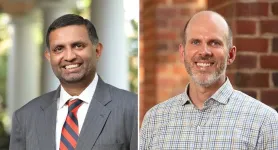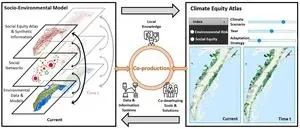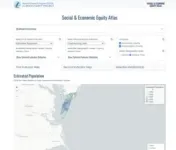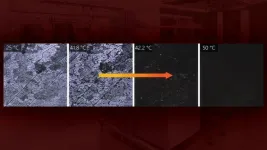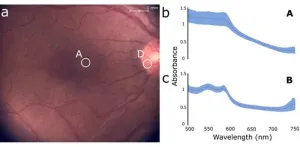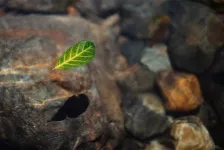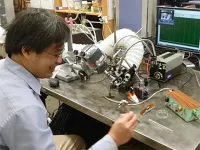(Press-News.org) Because of warming waters and melting glaciers, the sea level at Virginia’s Eastern Shore has risen almost 3 inches since 2016, and the projected trajectory looks ominous. The region, sandwiched between the Chesapeake Bay and the Atlantic Ocean, has one of the highest rates of relative sea-level rise on the Atlantic coast. The Virginia Institute of Marine Science’s Center for Coastal Resource Management projects a relative sea-level rise between 4.5 to 7 feet by 2100, which is three to four times the global average.
Hampton, Virginia — its neighbor across the bay — ranks second only to New Orleans as the largest population center at risk from sea-level rise in the country.
Too Much and Too Little
Since the Virginia Eastern Shore land mass is no more than 50 feet above sea level at any given point, it easily succumbs to saltwater intrusion, accelerated sea-level rise and storm flooding intensified by climate change. Saturated soil and swells of ground water destabilize buildings and can eventually cause the collapse of barns and homes. Farmland with elevated salinity cannot produce a healthy harvest — crops fail. Coastal erosion wears away soil and eliminates land altogether.
The predicament has been described as “too much” and “too little” — too much water where it’s not needed, for example intrusion and erosion, and too little where it is needed, such as not enough potable water.
Residents find it difficult to adapt to unpredictable environmental circumstances and their effects. Shore farmers, who have historically provided Virginia and the U.S. with a wealth of crops, now find that centuries of agriculture heritage are not enough to combat saltwater intrusion.
A group of UVA civil and environmental engineers and environmental scientists are teaming with local Shore residents on a project that aims to help these affected communities adapt to —literally and figuratively — an ever-changing landscape.
Empowering Communities with Technology
“We believe that the power of technology to transform communities and economies cannot be underestimated,” said Venkataraman Lakshmi, John L. Newcomb Professor of Engineering in the Department of Civil and Environmental Engineering in the School of Engineering and Applied Science. Lakshmi is one of the lead researchers on the project team.
Their work is supported by the National Science Foundation with a $5 million grant aimed to support “Coastlines and People Hubs for Research and Broadening Participation.”
Researchers are developing a web-based decision-support tool that will help residents deal with the challenges caused by climate change. The tool, called the Climate Equity Atlas, combines historical environmental data and socioeconomic data to create a sophisticated predictive tool that residents can use to make informed choices.
For instance, if your home collapses, where should you build a new one where the same incident will not occur again? Where is it most affordable to build? If your crops are ruined, is there a place on the Shore where the soil will support crops long term? Are there zoning limitations?
By engaging the community through events like the 2023 Eastern Shore of Virginia Climate Equity Project Winter Workshop, they are discovering different circumstances like these, then designing the Atlas to incorporate the different scenarios and predict near-term and long-term effects of different choices.
“The Atlas will enable ‘what-if’ discussions and projections of alternative adaptation strategies,” said Majid Shafiee-Jood, assistant professor of civil and environmental engineering.
Adapting to Climate-Induced Migration and Displacement
With climate-induced migration being a stark reality, the tool is also an attempt to keep community members from leaving the area. By providing the information they can make decisions not only about housing and farming, but how to connect with shifting population hubs to sell crops, start businesses and implement economic development plans.
Other issues such as saltwater-tainted wells, unreplenished aquifers and dislodged septic systems are public health concerns. According to a report by the Virginia Academy of Science, Engineering and Medicine, led by UVA professor of civil and environmental engineering Jonathan Goodall, without intervention 209 miles or 13.8% of the Shore’s road system could face permanent inundation as early as 2060.
The Atlas is a tool for governments and municipalities, too, so they can brainstorm adaptation strategies and remediation efforts for displaced people and infrastructure challenges — then use the tool to predict the effectiveness of different choices.
“We want to be able to tell who might be impacted — and who might be disproportionately impacted — by a decision,” Shafiee-Jood said.
Aiding Vulnerable Communities
Another main goal of the tool is to make sure no populations are left stranded without a path forward. The VASEM report also stated that lower income or racially segregated neighborhoods are often located in lower-value land tracts, including floodplains or flood-prone areas, and that residents and small businesses located in such areas are less likely to have the financial tools to protect their properties or relocate to less vulnerable areas.
“The research we’ve already done through VASEM on the impact of climate change can be plugged into the Atlas design,” Goodall said. “I’m thrilled that this data can help produce a tool so that this vibrant Shore community can continue to thrive.”
“We’re providing data in a way that can help the people in that region make decisions that put them in the best position to succeed,” said Duc Tran, a Ph.D. student gathering and analyzing the vast amount of critical environmental data needed to support this tool.
The Power of Data
“We’re being relentless about getting data,” Tran continued. “Because of our research, we found out that some National Oceanic and Atmospheric Administration (NOAA) and United States Geological Survey observatories have not collected data in certain years, so there were huge gaps in the environmental data. We’re utilizing remote sensing and lidar data to have more accurate predictions because we know the limitation of data availability is inevitable.”
Tran said he knows that with each component they build, they’re creating a foundation for resilience and for holding the community together. He hopes the things they learn and design for the Eastern Shore Atlas might be used to help other coastal communities around the world who are affected by climate change.
END
Navigating climate challenges: UVA engineers and environmental scientists aid Virginia’s eastern shore
2023-12-15
ELSE PRESS RELEASES FROM THIS DATE:
Using AI to pinpoint hidden sources of clean energy underground
2023-12-15
SAN FRANCISCO – As efforts to transition away from fossil fuels strengthen the hunt for new sources of low-carbon energy, scientists have developed a deep learning model to scan the Earth for surface expressions of subsurface reservoirs of naturally occurring free hydrogen.
Researchers used the algorithm to help narrow down the potential whereabouts of ovoids or semicircular depressions (SCDs) in the ground that form near areas associated with natural or “gold hydrogen” deposits. Though these circular ...
A study from IMDEA Software researchers reveals hidden fortunes and surprising overestimations in cybercrime revenue
2023-12-15
To what extent methodological limitations and incomplete data impact the revenue estimations of cybercriminal groups using the Bitcoin blockchain was largely unknown. A new study, conducted by IMDEA Software Institute researchers Gibran Gomez, Kevin van Liebergen, and Juan Caballero challenges existing figures regarding cybercriminals' Bitcoin earnings to date. The study, entitled "Cybercrime Bitcoin Revenue Estimations: Quantifying the Impact of Methodology and Coverage", recently presented at the ...
Department of Defense grant boosts study of pressure, humidity on thermal energy storage
2023-12-15
Under the Defense University Research Instrumentation Program, Dr. Patrick Shamberger and a research team from the Department of Materials Science and Engineering received a grant from the U.S. Department of Defense (DOD) to acquire instrumentation for thermal energy storage research.
The grant, administered through the Office of Naval Research, will support the acquisition of a high-sensitivity multi-modal calorimeter for advanced research and education on tunable energy storage materials. This equipment will allow cutting-edge research to study the capability of pressure and humidity to control how well these materials can store ...
IU researchers fill the final gaps in the Arabidopsis genome sequence and gain insights into gene regulatory mechanisms relevant to humans
2023-12-15
Arabidopsis thaliana is a species grown worldwide for genetic research and was the first plant to have its complete set of chromosomes (its genome) sequenced. The initial genome sequence, released in the year 2000, had numerous gaps, but technological improvements in the years since closed the gaps, one by one, until only two remained: large undefined regions on chromosomes 2 and 4 where genes encoding ribosomal RNAs are repeated in hundreds of copies. These ribosomal RNA gene clusters, known as nucleolus organizer regions (NORs), are not just difficult to define in Arabidopsis; gaps remain at ...
Toward more precise and flexible targeted spectroscopy measurements in the retina
2023-12-15
Many ocular diseases involve changes in the structure and function of different regions of the back of the eye, also known as the “eye fundus.” For example, fluorescent pigments and tiny yellowish deposits called drusen accumulate under the retina in age-related macular degeneration, and the degeneration of neurons called ganglion cells is a defining characteristic of glaucoma. Interestingly, changes in the eye fundus are not restricted to vision-related diseases only. Certain neurological diseases like Parkinson’s and Alzheimer’s can cause changes in retinal nerves and ...
UVA biomedical engineer unveils the dynamics of maternal immune responses
2023-12-15
Sepideh Dolatshahi, an assistant professor of biomedical engineering at the University of Virginia, is spearheading an exploration of systems immunology in its crucial development phase — during pregnancy.
Systems immunology is about unraveling concealed patterns within the human immune system, said Dolatshahi, whose approaches to her research span computational modeling, systems serology and cutting-edge spatial analysis techniques to investigate immune interactions between mother and fetus during pregnancy that could later support early childhood immunity.
Designing Tailored and Effective Vaccine Plans
Babies are immunocompromised ...
Novel therapeutic target overcomes resistance to radiation therapy
2023-12-15
A new study finds that radiation therapy (RT) suppresses a key protein called bone morphogenetic protein and activin membrane-bound inhibitor (BAMBI) and activates immune suppressive cells. These effects dampen the capacity of cancer-fighting immune cells and decrease the effectiveness of radiation, inducing therapy resistance in cancer patients, according to a paper published December 15, 2023 in the Journal of Clinical Investigation.
Radiation therapy is a common cancer treatment that kills cancer cells and activates immune cells to fight cancer. Yet this process also ...
Understanding atmospheric flash droughts in the Caribbean
2023-12-15
The word “drought” typically conjures images of parched soil, dust-swept prairies, depleted reservoirs, and dry creek beds, all the result of weeks or seasons of persistently dry atmospheric conditions.
In the sun-soaked islands in the Caribbean, however, drought conditions can occur much more rapidly, with warning signs appearing too late for mediation strategies to limit agriculture losses or prevent stresses on infrastructure systems that provide clean water to communities.
Such occurrences – known as flash droughts – are the focus of a new paper authored by Assistant Professor Craig Ramseyer of the College of Natural Resources ...
Pesticides and adjuvants disrupt honey bee’s sense of smell
2023-12-15
It has long been known that exposure to pesticide sprays is harmful to honey bees. In a new study, researchers have uncovered the effect of such sprays on the sense of smell in bees, which could disrupt their social signals.
Honey bees live in dynamic communities and constantly communicate with each other using chemicals that serve as social cues. For example, nurse bees—that are responsible for taking care of larvae that ultimately become queens and worker bees—constantly monitor the ...
Immune cells shape lung before birth and provide new avenues for treating respiratory diseases
2023-12-15
Immune cells play an active and intimate role in directing the growth of human lung tissue during development, researchers find, revolutionising our understanding of early lung development and the role of immune cells outside of immunity.
The research offers new insights for understanding and treating respiratory conditions, such as chronic obstructive pulmonary disease (COPD). Respiratory conditions account for almost 20 per cent of all deaths in children under five years worldwide1.
The work reveals a surprising coordination between the immune and respiratory systems, much earlier in development than previously thought. This discovery raises questions about the ...
